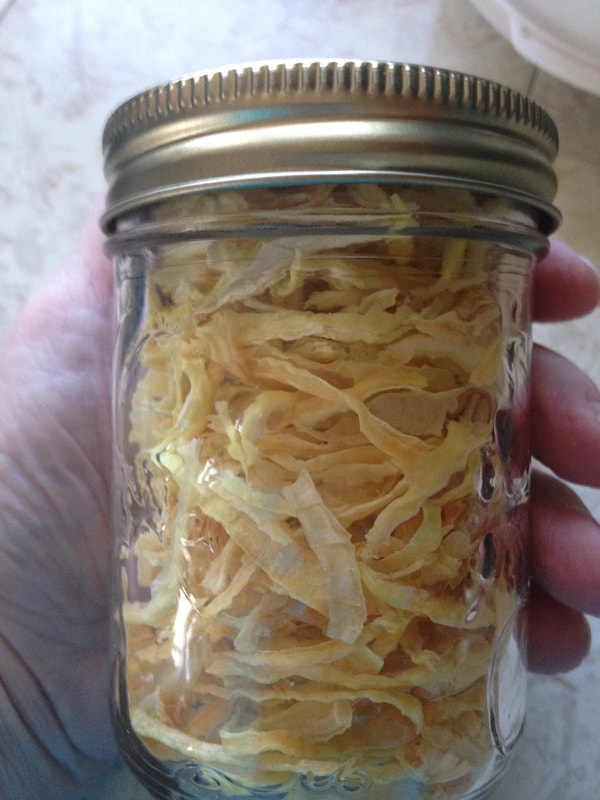Then one day, the musical voice said, “It’s time, my lovelies.”
Tugging on our tops, a hand lifted us into the fall sun. My how we had grown! Dressed in our golden topcoats I wondered what adventure will be in store for us next?
Since a root cellar is no at my disposal, I prefer to dehydrate onions fresh from the local farmer’s market. They keep forever and the flavour returns as the strips of onion hydrate in the chosen recipe. I will also break them into chunks or grind them depending on what i am cooking.
I have used the outer layer (skin) from golden onions to make a dye. Using plants to dye fabric and leather has been going on for generations, and appears to be making a comeback
Pouring boiling water over the parchment-paper-like coat, then letting it cool. A beautiful hue of auburn gold results and is perfect for dyeing white cotton for quilting. There has been an occasion when I have used it to repurpose a vintage piece of linen that may have been stained. A stain that refuses to come out but the piece is still worthy of keeping and using.
Depending on the size of the linen or cotton factors into how I choose to dye it.
For small pieces, I use the cauldron method. One that fits nicely all of the bits and pieces needed.
First, yellow onion skins, as many as you have, go into the pot. The quantity used may also be determined by the colour you think you want to attain. More skin makes for a darker shade. The boiling water goes in next. Bring back to a rolling boil before turning the heat down to simmer until you get the colour you want.
Yes, the house might smell like onions. It will pass, or open a window, or light a candle to burn nearby.
This is where there are a few methods to contemplate.
- If you are happy with the colour, remove all of the onion skin. Add the fabric, submerging completely before simmering for 15 - 30 minutes. The dye needs to saturate the material. Remove the fabric and plunge into ice (cube) water. This will help to set the colour. Slosh it around using a wooden spoon, then rinse under a stream of cold water until the water from the fabric runs clear. Hang the piece to dry or lay it on a towel to dry.
- If you want a mottled look, leave the skins in the cauldron. Add the fabric and submerge completely, stirring it gently to incorporate the onion skins in the folds. Simmer for 15 - 30 minutes. Turn the heat off and let the water cool with the skins and fabric still in the pot. When the water and fabric are cold enough to handle, pour the contents of the cauldron through a strainer/sieve. (Side Note: Keep the dyed water for future use. It will be a much lighter shade, but still useable.) Once strained, let the fabric start drying in a clump with the onion skins still intertwined. Remove the skins by rinsing the material in a bowl of water. There should be darker shades of colour where the skin has been left. Finish the rinse under a stream of cold water until the water from the fabric runs clear. Hang to dry or lay on a towel.
In either way, there may be a smell of onion lingering on the fabric. Let the piece dry completely. In the case of vintage pieces, launder as you would any other old piece. Cotton for quilting should be laundered normally before using it. I suggest you do not dry either in a laundry dryer. This will help to set the colour, but it will also help to set any smell of onion. Hanging to dry outside is the best method.
| Ann Edall-Robson Author, Photographer, Lover of Life "Capturing moments others may never get to experience.” |


 RSS Feed
RSS Feed